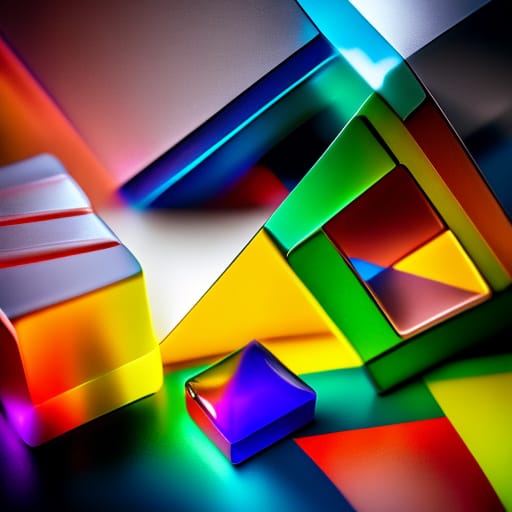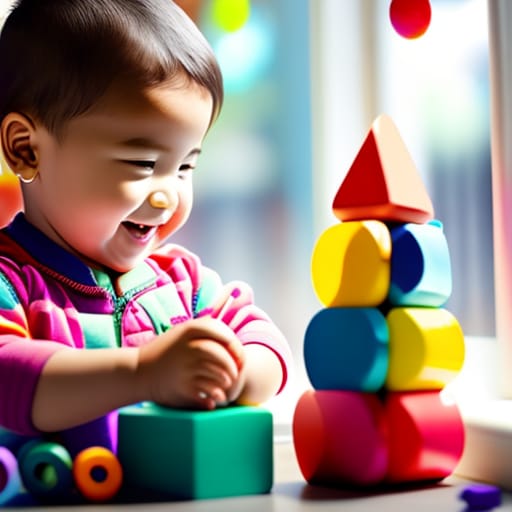Magnetic building blocks are a popular educational toy that offers a world of fun, creativity, and learning for kids. As a parent, you may be curious what magnetic blocks are, what benefits they offer, and which sets are the best options for your child. This beginner’s guide covers everything you need to know about magnetic building blocks for kids.
What Are Magnetic Building Blocks?
Magnetic building blocks are sets of puzzle-like construction pieces made of durable plastic, wood, or other materials embedded with magnets. The magnets allow the pieces to stick together securely in a variety of ways, letting kids build elaborate structures from their imagination.
Unlike normal building blocks that rely on gravity or friction, magnetic blocks utilize magnetic force to stay together. This allows for more complex and creative designs. Magnetic tiles and blocks also spark more engagement, focus, and open-ended play as kids experiment with magnetism and spatial reasoning.
Most magnetic building sets include different shapes and sizes like squares, triangles, rectangles, trapeze pieces, arcs, and more. Some also contain specialized blocks like columns, window frames, wheels, people, animals figures that enhance design options.
Key Benefits of Magnetic Blocks
Magnetic building blocks offer a range of developmental benefits for kids:
- Promote STEM learning – Magnetic construction play teaches kids about engineering, architecture, geometry, spatial reasoning, and basic physics concepts like magnetism in a hands-on way.
- Enhance creativity & imagination – Building anything they dream up sparks creative thinking, problem-solving, and storytelling.
- Develop fine motor skills – Precision required to connect blocks builds dexterity, grip strength and hand-eye coordination.
- Grow cognitive abilities – Seeing connections between pieces fosters pattern recognition, planning skills, cause & effect relationships.
- Allow collaborative play – Building together lets kids negotiate, share ideas, compromise, and think flexibly.
Many parents and educators love the open-ended versatility of magnetic building blocks. Kids guide their own experience through intrinsic motivation and curiosity rather than following rigid step-by-step instructions. This self-directed learning is excellent for development.
Magnetic blocks also easily integrate into lessons on architecture, geography, shapes, spelling, and more for seamless educational play. Overall they provide hours of enriching, screen-free fun filled with learning.
Types of Magnetic Building Blocks
There are a few main types of magnetic building blocks:
Magnetic tiles feature various geometric shapes like squares, triangles and trapezoids embedded with magnets. Popular brands like Magna-Tiles and Picasso Tiles offer sets with vibrant colors that can be arranged into diverse 2D mosaics and 3D structures.
Magnetic blocks come in basic square brick shapes reminiscent of normal building blocks, but with magnets inside. Leading brand Magformers offers magnetic block sets with thematic shapes and accessories for open-ended construction play.
Alternative magnetic builders use interlocking balls, straws, rods, connectors or rings embedded with magnets rather than tile or block components. Examples include Geomag, Magnetix, ZOOB and K’Nex. These foster different building approaches.
Specialized magnetic construction kits focus on niche interests like architecture, engineering, chemistry or anatomy using domain-specific magnetic parts. Magna-Qubix, Anatomy Magnetics and Thames & Kosmos kits take magnetic building to new educational heights.
With all these sets, the magnets allow for secure construction while still being easy to detach and rearrange pieces as kids experiment. Strong neodymium or ferrite magnets guarantee proper connectivity.
Top Magnetic Building Block Brands
Based on parental reviews and expert analysis, here are 5 top-rated magnetic building block brands for kids:
1. Magna-Tiles
- 32 piece & 100 piece sets
- Vibrant colors & shapes
- Excellent quality
- Promote stem skills
- For ages 3+
- $$-$$$ price range
2. PicassoTiles
- 30 – 100 piece sets
- Vivid colors & design flexibility
- Durable construction
- Boost spatial reasoning
- For ages 3+
- $-$$ price range
3. Playmags
- 25 – 100 piece sets
- Bright colors & creativity
- Excellent value
- Develop fine motor skills
- For ages 3+
- $ price range
4. Magformers
- 14 – 100 piece sets
- Theme-based kits
- Fun and engaging
- Encourage STEM learning
- For ages 3+ years
- $$ price range
5. Geomag
- 92 – 708 piece sets
- Unique panther & line design
- Innovative building styles
- Ideal for older kids
- For ages 5+
- $-$$$$ price range
With engaging open-ended magnetic play, durable parts, vibrant colors and compatibility between sets, brands like Magna-Tiles, PicassoTiles and Magformers rank highly with parents. Look for age recommendations and start with smaller sets first.
Factors to Consider When Buying
Here are key factors parents should keep in mind when selecting magnetic building blocks:
Child’s age – Choose age-appropriate sets to align with developmental needs and interests. Magnetic play requires coordination and dexterity to piece together, so very young kids may struggle. 3 years old is ideal.
Number of pieces – Start small with around 25-50 pieces to limit overwhelming and overstimulation. Build up to more complex 100+ piece sets as kids skills progress. Consider multiple small sets rather than one large set.
Shape variety – Look for at least 4-5 basic shapes like squares, rectangles, triangles, arches to encourage more diverse building. Accessory pieces like people, animals, wheels etc. also boost engagement.
Colors – Vibrant primary colors appeal most to young kids while clear transparent pieces unlock advanced light trick illusions for older kids. Combining colors also aids creativity.
Safety – Ensure sets pass toy safety standards like ISO 8124, EN 71, or ASTM F963. Supervise play to avoid magnets loosening and ingestion hazards.
Portability – Portable tins or satchels allow bringing sets on-the-go for travel play. Consolidating pieces in storage bins also helps limit losing them.
Budget – Consider value for money across budget-friendly and premium sets. More pieces typically increases cost, but not always quality.
By evaluating these aspects, you can select appropriate, enriching magnetic block sets kids will love playing with.

Using Magnetic Blocks Educationally
While kids will naturally enjoy inventing with magnetic blocks, parents and teachers can also guide play to maximize learning potential:
- Foster STEM skills by asking guiding questions during play:
- What shapes/colors do you see?
- How could you build a stronger structure?
- What happens if you turn the magnets opposite ways?
- How could you build a robot/bridge/house?
- Relate magnetic construction to real-world concepts:
- This triangle roof is like the Empire State Building
- These blue blocks are the river, and we need a bridge to cross over
- Let’s make a zoo and build homes for all the animals
- Integrate magnetic blocks into activities:
- Spell words, names, shapes
- Sort by color, shape, size
- Create repeating patterns and mosaics
- Follow building challenge cards
- Provide accessories like toy people, animals, cars to inspire roleplay and storytelling during building. Encourage kids to describe what’s happening with their creations.
- Display kids’ magnetic block structures proudly around home or classroom to validate creative efforts.
Leveraging magnetic blocks for education purposes elevates their play value significantly while still letting kids direct the experience based on innate curiosity and exploration.
Safety Considerations
While magnetic building sets pose significantly less risks and hazards compared to smaller loose magnets, parents should still take reasonable precautions:
- Supervise play: Monitor kids to ensure no loose magnets or placing blocks in mouth to reduce ingestion risk
- Check condition: Make sure all magnets are secure after play and discard any loose magnets
- Mind age ratings: Follow manufacturer recommended age guidelines that factor safety. Most specify 3+ years.
- Limit access: Store magnetic blocks out of reach from younger kids and pets when not in use
- Avoid metallic items: Keep blocks away from electronics, credit cards, jewelry that could be damaged by magnetism
- Research brands: Select reputable manufacturers that follow toy safety standards and test magnet adhesion.
While magnetic building blocks inspire great developmental benefits, small parts do pose some safety risks requiring reasonable precautions. Proper adult supervision is key, especially for kids under 3 years.
Encouraging Ongoing Innovation
Magnetic blocks inherently spark creativity and problem-solving skills in kids. As children build masterpieces, praise them for their ingenuity and display structures with pride. Pose occasional questions about their design to encourage thinking deeper.
You can also present magnet block challenges to motivate new innovations like:
- Build the tallest tower possible
- Create a house with 5 rooms
- Use all the green blocks in one structure
- Build something with symmetry/that has a pattern
- Construct a bridge that spans 8 inches
- Design artwork with images in mind
Swap out accessories like toy people, animals, and vehicles and ask kids to build new environments like a city, farm, or zoo to match. Introduce new pieces like dowels, strings, cardboard cutouts to integrate into structures.
Finding the balance between child-led exploration and adult-guided challenges with magnetic blocks keeps innovation flowing. Displaying childrens’ creations as stunning art pieces also boosts their sense of pride and accomplishment.
Choosing Age-Appropriate Sets
Magnetic building sets promote developmental benefits across age groups:
Toddlers (1-3 years) – Simple starter sets under 30 pieces with large magnets appeal most to coordination and motor skills of toddlers first discovering magnetic play.
Preschoolers (3-5 years) – Colorful 25-50 piece sets with basic shapes build fine motor control. Foster pattern and shape recognition, spatial and problem-solving skills essential for early math and science.
School-age (5-9 years) – More complex 100+ sets with varied shapes, triangles, accessories enable school kids to construct elaborate structures. Advanced sets inspire STEM curiosity applying engineering and physics concepts.
While most brands suggest ages 3+ for magnetic builders, look for chunkier pieces and maximum supervision if purchasing for children under 3 years due to small parts risk. Larger, lightweight blocks suit toddlers best while transparent Magna-Tiles build visual spatial skills essential for older kids.
Pay attention to interests too. Girls may love kits with cute accessories like pretend food, animals and people for roleplay. Boys tend to gravitate toward bold primary colors and transportation themes.
No matter their age, all kids thrive thanks to the limitless three-dimensional creativity, spatial skill-building and imaginative play magnetic blocks provide!
Promote Development Through Magnetic Play
Beyond sparking endless engagement and fun, playing with magnetic blocks uniquely supports cognitive growth across developmental domains:
Spatial intelligence – Envisioning and manipulating 3D structures boosts spatial reasoning abilities. Crucial for math and science thinking.
Problem-solving skills – Trial and error to balance irregular shapes into position requires critical thinking.
Creativity – Combining pieces in new ways and roleplaying stories stretches imagination and brain power the more kids play.
Fine motor skills – Precision grasping patterns and snapping pieces together builds finger dexterity and strength.
Pattern recognition – Spotting magnetic polarity patterns trains young minds to notice relationships. Crucial ability for reading, writing and mathematics.
Collaboration – Building together lets kids discuss ideas, negotiate roles, compromise on designs and think flexibly.
With open-ended possibilities, magnetic blocks empower kids to experiment, test theories and reach own conclusions through natural curiosity – exactly the way young minds learn best!

The Appeal of Magnetic Open-Ended Play
Child development experts overwhelmingly recommend open-ended toys like magnetic tiles that have no defined right or wrong way to play. This fosters creativity, problem-solving and imaginative learning essential for future success.
Magnetic blocks possess unlimited possibilities meaning children dictate the direction through innate curiosity – not some pre-defined roadmap. There are no step-by-step instructions to follow. Kids simply tinker, test, and try new arrangements guided only by their motivation and interest.
This self-directed experimentation teaches key life lessons:
- Trial and error persistence to solve problems
- Spatial orientation abilities
- Flexible thinking seeing endless solutions
- Fine motor control snapping together pieces
- Causality observing what magnetic attraction enables
- Structural engineering seeing what designs work
Rather than quickly getting bored of toys with singular functions, magnetic blocks literally transform in children’s hands to become anything they envision. This builds creative confidence and the 21st century skills necessary for innovation.
So while playing with magnetic blocks sure looks like fun playtime, tremendous learning happens simultaneously setting kids up for developmental success!
Magnetic Building Promotes Early STEM Learning
Magnetic tiles seamlessly build early science, technology, engineering and math skills making them a top pick for STEM learning:
- Science – Exploring magnetism fundamentals excites natural curiosity about physics and properties governing our world
- Technology – Seeing structures hold together mysteriously induces inquisitiveness about the invisible forces at play
- Engineering – Trialing what works to balance irregular blocks into functional structures develops core engineering ideation skills
- Mathematics – Recognizing shapes, symmetry, patterns, sequencing all reinforce early geometry and math skills
This interdisciplinary learning happens completely organically simply through the act of play. Kids deduct key principles about structural design to build stable creations. They problem-solve angles and forms needed to span gaps or create enclosures. Mastering spatial manipulation hones foundational cognitive abilities for logical mathematics thinking.
Guiding play with questions makes learning connections even more explicit:
- How did you get your tower to go so high before it fell over?
- What shapes do we need more of to complete this wall?
- I wonder if we can combine these pieces to make a new shape?
- How else could we arrange them by color/size/material?
Rather than passive consumption of content on screens, magnetic blocks put kids in the driver’s seat of active learning through interactive creation. Early STEM skills manifest intuitively this way to prime young minds for later success in technical fields.
The Verdict: Are Magnetic Blocks Worth the Investment?
For parents debating whether magnetic building sets provide enough play value relative to cost compared with regular blocks or other toys, the enriching developmental upsides make them well worth the investment long-term:
Infinite play possibilities – Open-ended magnet blocks literally transform into anything kids imagine through creative problem-solving compared to toys with fixed functions.
Reusable value – Quality magnetic sets like Magna-Tiles withstand years of use, effectively lowering cost-per-play value over time.
Universal skill-building – Magnetic play organically builds cognitive abilities like spatial reasoning, pattern recognition and critical thinking that benefit early development across ALL disciplines.
Future-proof skillset – Nurturing imagination, inquisitiveness, persistence and innovation through magnetic play prepares kids with the 21st century toolkit necessary for ongoing success.
While the upfront cost of quality magnetic building sets may exceed regular toys, the embedded long-term developmental benefits make them a worthwhile investment into any child’s future.
Final Thoughts
Magnetic building blocks offer tremendous versatile play value plus significant early learning advantages that fast become a necessity for any young child’s toy collection.
Open-ended magnetic tile play nurtures creativity through guided exploration as kids experiment combining pieces to build elaborate constructions limited only by imagination. Developing spatial reasoning, engineering instincts, fine motor skills and problem-solving confidence all emerge through hands-on magnetic fun.
As kids delight in magnetic construction play, they simultaneously inch closer to cognitive milestones essential for academic achievement.
Whichever brand or set you choose, the developing benefits unlocked through creative magnetic block play make them well worth the investment! Adding magnetic blocks to your kids’ toy collection helps ensure they reap the developmental upsides of this versatile educational toy.
Frequently Asked Questions
What are the best magnetic building blocks for a 2 year old?
For toddlers, opt for larger, chunkier magnetic blocks like Magna-Tiles Dots, Playmags Jumbo, or Magformers Wacky Learning Cubs. Pay attention to safety with maximum supervision, as pieces still pose a choking risk. Guide play by demonstrating how blocks connect. Ask them to hand you pieces to develop fine motor skills.
How do magnetic building blocks compare to Lego or regular blocks?
Magnetic blocks add an extra element of fun through the novelty of magnetism. They stick together in countless ways, inspiring more elaborate 3D creations. The built-in magnets foster more engagement, focus, and open-ended play. Pieces also securely hold together, preventing frustrating collapses kids experience with regular blocks.
Do magnetic building block brands connect together?
Some brands like PicassoTiles and Playmags reliably connect, while others like Magna-Tiles suit standalone play better. Examine product descriptions to confirm cross-compatibility. Trying sets specifically labeled as compatible e.g “adds on to Magna-Tiles” increases chances of integrated play.
How can magnetic blocks help develop STEM skills?
The act of imaginative building promotes STEM learning:
- Science: Exploring fundamentals of magnetism and physics
- Technology: Seeing invisible forces causing pieces to attract
- Engineering: Discovering what structures best balance and connect
- Math: Recognizing shapes, patterns, sequencing, spatial logic
Are magnetic building blocks safe?
Reputable magnetic toys with certified parts that comply with strict safety standards pose little risks when used properly under adult supervision. Still take reasonable precautions:
- Supervise play for kids under 3 years
- Check all magnets are secure after use
- Avoid near electronics, credit cards etc. that could be damaged
What are magnetic building blocks made of?
Quality magnetic building sets like Magna-Tiles and PicassoTiles use durable ABS plastic for the blocks, securely housing strong neodymium magnets. Some brands offer transparent Lucite blocks. Avoid cheap kits with painted wooden blocks and loose magnets.
